OneNote is a digital notebook that provides a single place for all of your notes and information—everything you need to remember and manage in your life at home, at work, or at school.
In OneNote, your notebooks never run out of paper. They’re easy to reorganize, print, and share, and they have a fast search feature so you can recall anything instantly. Best of all, you can store your notebooks online and use them from anywhere.
Here are some of the basic steps to help get you started with OneNote.
Create a new notebook
When you first start OneNote, it creates a sample notebook for you. You can use this notebook or quickly create your own.
-
Click File > New.
-
Select one of the available locations (for example, OneDrive), or click Add a Place to tell OneNote where you want to store the new notebook.

-
Follow the screen prompts you see. When your new notebook is ready, it will open to new section that has a single blank page in it.
Tip: New pages are typically blank. If you prefer a more decorative design, you can apply a template to a new page by clicking Insert > Page Templates > Page Templates.
Type or write notes
When you’re ready to take notes, do any of the following:
-
To type notes on a page in OneNote, click wherever you want them to appear, and then start typing.
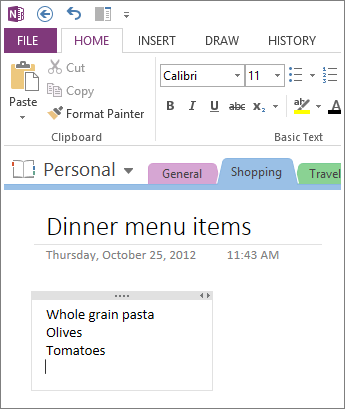
-
Whenever you want to begin a note elsewhere on the page, just click and start typing there.
-
To add a page title, click the page header area at the top of the page and type the title. Titles also show up in the page tabs near the right of the page.
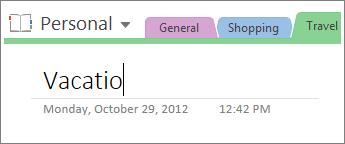
-
If your computer supports handwriting, click the Draw tab on the Ribbon, select a pen, and then draw or write directly on your screen.
Add links
Whenever you type text that OneNote recognizes as a link (also known as a hyperlink), OneNote automatically formats it as one. For example, if you type www.microsoft.com into your notes, OneNote turns that into a link. Clicking it will open the Microsoft website in your browser.
You can also manually insert links into your notes (including links to text, pictures, and to other pages and sections of your notebooks), by doing the following:
-
Select the text or picture you want to link.
-
Click Insert > Link.
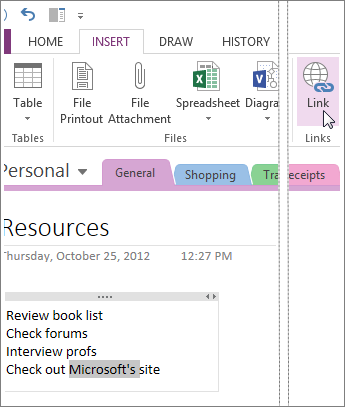
-
In the Link dialog box, type the link’s destination URL into the Address field and then click OK.
Add files to your notes
OneNote can keep all of your information about any subject or project together in one place — including copies of related files and documents.
-
In your notes, go to the page where you want to insert a file or document.
-
Click Insert > File Attachment.
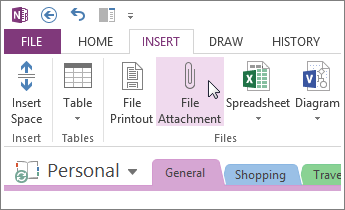
-
In the Choose a file or a set of files to insert dialog box, select one or more files, and then click Insert.
Inserted files show up as icons on your notes page. Double-click any icon to open its file.
Remember, inserted files are just copies. OneNote doesn’t automatically update the copies if the original files change.
Insert pictures
You can insert screen clippings, photos, scanned images, cell phone photos, and any other kind of images into your notes.
-
On any page, put the cursor where you want to insert the picture.
-
Click Insert and then do one of the following:
-
Click Screen Clipping to capture a selection of your computer screen and insert it as a picture into your notes.
-
Click Pictures to insert a picture file that’s stored on your computer, your network, or another disk drive, such an external USB drive.
-
Click Online Pictures to find and insert pictures from a Bing Image Search, your OneDrive account, or elsewhere on the Web.
-
Click Scanned Image to scan a picture into OneNote with a scanner that’s attached to your computer.
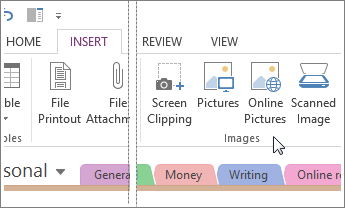
-
Draw a table
Tables are a great way to organize information in your notes pages. Start by drawing a simple grid.
-
Click Insert > Table.
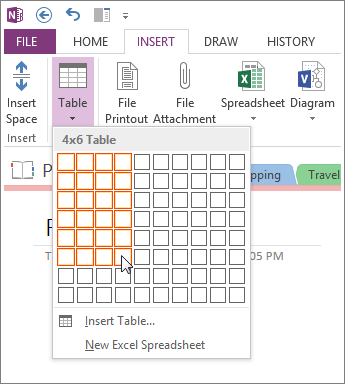
-
Move the mouse pointer over the grid to select the table size you want, and then click the left mouse button. For example, selecting a 4x6 table would create a table with 4 columns and 6 rows.
To quickly modify a table or any of its parts, right-click any table cell, click Table, and then use the commands on the menu.
Tip: If a table gets to be too complex, you can convert it into a real spreadsheet right in OneNote. Right-click the table and then click Convert to Excel Spreadsheet.
Add more pages
For more room in your notebook, add as many pages as you want.
-
In the section of your notebook that you want to add pages to, near the right side of the page, click Add Page once for each new page you want.
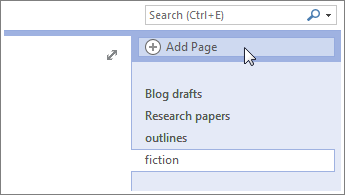
-
When you’re ready to use one of the new pages, type a page title into its page header area, and then press Enter.
Tip: To change the order of your pages, click and drag any page tab to a new position.
Add more sections
Sections in OneNote are like the color tabs in a typical 5-Subject paper notebook. Unlike paper, however, OneNote lets you create as many sections as you want.
-
Right-click any section tab at the top of the current page, and click New Section.
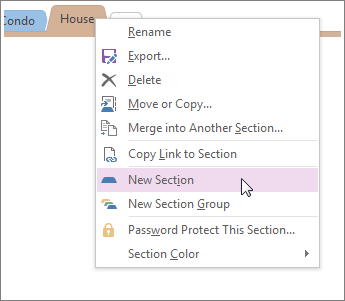
-
Type a title for the new section, and then press Enter.
New sections always contain one blank new page. You can start taking notes on this page or delete it and start with a page from your favorite template.
Save your notes
OneNote doesn’t have a Save button. That’s because you never have to save your work in OneNote like you do in other programs.
As you work in your notebooks, OneNote automatically saves everything for you—no matter how small or large the changes you’ve made. This frees your mind to let you think about your projects, thoughts, and ideas instead of thinking about your computer files.










